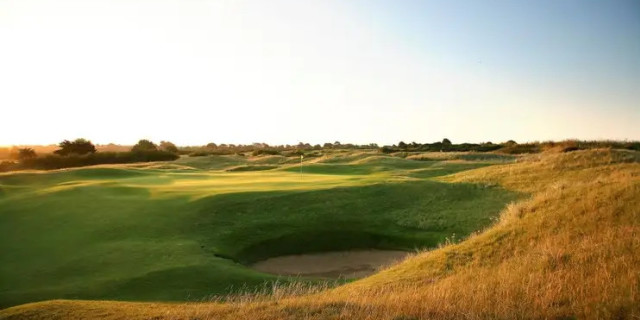
Royal Lytham & St Annes Golf Club Feature Review
Review by Golfshake Ambassador Andy Picken
Royal Lytham & St Annes Golf Club is the most northerly of the Open Championship venues in England, situated around ten miles as the crow flies from its neighbour Royal Birkdale.
In the 1976 edition of Choice of Golf Courses written by Frank Pennink, he describes the early history of Royal Lytham, which was founded in 1886 near to the present site of St Annes Old Links. It was moved to its current location in 1897, originally designed by George Lowe, the club's first professional. However, design input from such greats as Harry Colt, Herbert Fowler and Tom Simpson have added value and strategic difficulty across the ages.
I love reviewing a club’s history and this is one of the best. The club website has a separate listing for each of the major events it has hosted. There is no clearer indication of its pedigree. This is broken down into elements including The Open (11 times, latest 2012), the Walker Cup (2015), Ryder Cup (twice, 1961 and 1977), Curtis Cup (once 1976), Senior Open (5 times, latest 2019) and Women’s Open (once, 2018).
The Setting

Due to COVID-19 restrictions, I was not able to fully view the memorabilia usually displayed as parts of the clubhouse were sealed for safety and cleaning. Those I did see were impressive in their own right.
Simply walking the corridor to the toilets gave access to framed memorabilia detailing Bobby Jones, Tony Jacklin, Seve Ballesteros, Ernie Els and Gary Player. Each frame reminded me of TV coverage from famous incidents that have been linked to this great course.
This is a links course, but it is at least half a mile from the sea. The west boundary is formed by the busy railway lines, the rest of the course boundaries are houses and suburbia.
The Victorian style clubhouse is beautiful affair with a Dormy house attached for the use of visiting golfers. I intend to revisit and avail myself of this facility at some point in the future.
My long-term hero Bernard Darwin describes Royal Lytham and St Annes in his book the Golf Courses of the British Isles as; “A beast, but a just beast.”
The practice facilities are excellent, with a driving range and short game practice area of Open standard, adjacent to the clubhouse.
Front 9 Overview

(The 1st Hole)
Unusually the course opens with a par 3, 206 yards from the back tee. Out of bounds lurks in play along the length of the hole on the right. This is to protect an active railway line. Substantial, well established trees mask its proximity but also have the effect of shielding the 1st tee from the prevailing winds. This is a factor to consider when selecting a club.
As a golf history geek, Royal Lytham has the feel of an interactive museum. Many of the holes bring back immediate memories of famous moments from the past.
I recall watching Ian Woosnam nailing his opening shot at this hole to a few feet, making birdie. Only to find as he stood on the 2nd tee that his bag contained 15 clubs! The subsequent penalty cost him £225,000 possibly the Open Championship.
We found that a bold approach to the 2nd and 3rd holes paid a dividend, but these required well struck approaches following decent drives. From the 2nd tee you are aware of the OOB for the length of the hole down the right side. Bunkers are placed perfectly for anyone being timid playing away from this hazard.
The 3rd continues this theme as it hugs the boundary provided by the railway line. The trees mask its presence but it is a real factor when deciding lines of attack from the tee box.
The 5th is a brilliantly bunkered hole. The routing has changed so that you are now playing into the prevailing wind. The acuteness of the dog-leg brings in a range of playing options.
Skipping ahead to the 7th, which is a cracking par 5. Again, it follows the course boundary with the entire hole protected to its right side by OOB. The placement of the bunkering is superb.

(The 7th Hole)
The 8th plays from an elevated tee that is a little more exposed than most. Please note that there is a footpath that crosses the course and pedestrians using it come into view very quickly from behind the boundary foliage. Dead ground features at the front of the green between cross bunkers. I visited the one to the left of the green despite knowing that it was the deepest on the course. A career best sand save followed. A memorable hole.
Finally, the 9th is a beautiful short hole that caused consternation for our group from the tee. Nine bunkers protect the green, which has a number of subtle humps and hollows. Sound club selection is vital. It is strange to see such a visually striking golf hole in the midst of houses. If this had a beach location with crashing waves it would be globally iconic. I could hear the sound of a builder’s drill as a nearby property was being renovated.
Back 9 Overview

The back-nine opens with a stunning hole requiring a threaded drive between mounds that are additionally supported by bunkers.
Playing 601 yards from the competition tees, the rough on the 11th guards errant shots and is penal and strong, twisting club heads off-line.
The 12th is a difficult par 3 that I failed to best. Heavily bunkered with a raised green, it is a hole I want to return to try again and again. The green is angled left to right with a false front.
Jumping ahead to the 14th, driving lines off the tee are crucial to avoid bunkers and sand hills and still leave an angle into the green. Penal rough and the course boundary add further to its delicious challenges.
The 15th elicited a comment from Jack Nicklaus when playing the 1974 Open. He said; ”God, it’s a hard hole.”
Indeed, it caused my only no score of the round. Superbly bunkered in between the dunes leading to semi blind approaches. Memorable, despite failing dismally to best it.
The 16th has a blind drive with a marker post designed to provide guidance on lines towards a raised green. Fabulous bunkering together with an undulating make this a gem. This is Seve Ballesteros' famous car park hole during his first Open win.
The 17th will be forever associated with Bobby Jones after his ball found a sandy waste area and he powered an approach shot onto the green over rough, bunkers and scrub ground, causing his opponent to three-putt in shock. A plaque gives a permanent record of this feat for those who follow in his footsteps.
Closing the round, the 18th is remembered for Tony Jacklin and his immaculate drive to win his Open and set British golf back into prominence. I think also of Gary Player shouting at the members in the patio overlooking the green as he prepared to play his shot. As I played this hole, the views back towards the clubhouse were memorable and spine tingling. Diagonal bunkers in a string provide excellent defence for this hole.
Post-Round Thoughts

There are 174 bunkers in play on the course. I certainly found what I considered to be more than my fair share of them. However, they are beautifully conditioned, and I defy any amateur golfer to play this course without becoming acquainted with them. All are exceedingly well placed.
Unusually for a links course, Royal Lytham is set in a suburban environment between houses and railway lines. There are none of the usual sea vistas but there are still some incredible views, particularly when coming back to the clubhouse. Many of the slopes and swales that are built into the green complexes are designed to increase substantially the effective footprint of the bunkers. This is done subtlety, so care needs to be taken with shot placement. The bunkering on all the short holes is imposing and intimidating.
Ultimately, Royal Lytham & St Annes represents one of the finest tests of golf available in the United Kingdom. Having taken RLSA off my bucket list, I am replacing it back as I now find it necessary to play it over two days and discover the delights of the Dormy House. This was a golfing experience of the finest order that I need to repeat.
Overall Rating - 9
Course (Conditions) - 9
Course (Hole Variety/Layout) - 9
Course (Green Condition) - 10
Course (Challenge/Difficulty) - 10
Club Facilities & 19th/Clubhouse - 10
Practice Facilities - 10
Friendliness/Hospitality - 10
Pace of Play - 9
Value for Money - 10
About the author

Andrew Picken is a Golfshake ambassador and prolific golf traveller who writes course reviews, travel features, and destination guides. A passionate golfer for over two decades, he plays regularly across the UK and Europe and is involved in several golf societies and charity events. Andrew is committed to promoting the game and showcasing the variety of golfing experiences available to enthusiasts of all abilities.
Related Content: travel review England Courses





